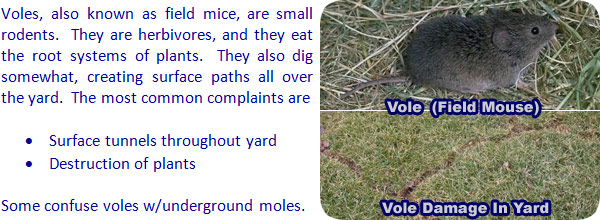- info@wildlifeanimalcontrol.com
Call us for help in your town
Wildlife Control Education
Vole Repellent Analysis

Need vole removal in your hometown? We service over 500 USA locations! Click here to hire us in your town and check prices - updated for year 2020.
Tips On Repelling Voles
Voles, commonly called field mice, are short compact rodents with little eyes. These rodents are about four to eight inches long and can multiple very quickly by having five to ten litters per year with each litter containing five to ten babies. It is not unusual to mistake a vole for a gopher since both live underground in burrows with many exits. In fact, if there is an abandoned gopher hole the vole will take up residence. With the exception that voles are active day and night, they are very similar to other rodents in the area. Because of their burrowing and tunneling ability you may not even know you have a vole problem until you see dead plants everywhere.
The vole is thought to be like similar rodents this size, but in reality they have a little bit of characteristics from many of the other rodents, especially when it comes to food. They will feed on insects including grubs, like moles and like shrews they will eat dead mice and rats. The vole can live on most fruits or nuts and loves plants more than most. It will girdle or eat the bark of a small tree to the point that the tree can die, and will eat out root systems of plants from under the ground until they die. It is not uncommon for voles to tunnel under ground and come up under bulbs and roots to feast while you are unaware that your plants are being devoured. For a person who doesn’t carefully inspect their garden it can be frustrating to lose plants to these critters without understanding why.
Repelling The Voles
Since voles are very similar to other burrowing rodents you can use the same tactics for getting rid of them as you do moles and gophers. The problem with the vole is that they will leave a lasting odor that can draw other pests. This odor can last up to a year and will draw more rodents to your area. It will be important to have repellants for some time after you get rid of them. Their natural predators are the owl and the coyote so using coyote urine around the property boundary will keep voles away. Encouraging owls to take up residence with a barn owl box will help with all rodents. A direct repellant is Ropel liquid which can be applied directly to the ground and any bulbs that you want to plant.
Other Types Of Repellants
Barrier methods of keeping voles away are used in garden areas. These are usually chicken wire fence material that is below the ground around root systems and up the sides of the garden. Another effective way of deterring the vole along with the barrier method is to plant marigolds, castor bean plants, and Scylla. Smell aversion methods along with coyote urine include making a blend of castor oil and ammonia mixed with soap. This mixture and be soaked into rags and put into infested burrows which will send the rodents scampering away. There are commercial repellents that are available such as Whole Control and Vole Repellant Granules but since these are made of strong chemicals it is recommend checking for the safety of pets, children, people and other wildlife.
Trapping the Voles
It is possible to trap voles and depending on the size of the infestation there are several different commercial traps available. Trapping these rodents will be similar as trapping gophers and moles. In fact, tunnel traps and expanded trigger traps can be used for any rodent problem. The bait that will be used is according to the area that you live in and what is available that the rodent enjoys eating. For example, if your area is known for pecan trees and Loganberries than getting a paste in those flavors will draw the vole to your traps.
More in-detail how-to vole removal articles:
Information about vole trapping - analysis and methods for how to trap.
Information about how to kill a vole - with poison or other methods.
Information about how to keep voles away - prevention techniques.
Information about how to catch a vole - remove one stuck in the house.
This site is intended to provide vole deterrent education and information about vole repellents, such as those you can buy at Home Depot or Lowes, so that you can make an informed decision
if you need to deal with a vole problem. This site provides many vole control articles and strategies, if
you wish to attempt to solve the problem yourself. But remember, mothballs and fox or coyote urine won't do the trick, nor will high pitch sound or noise machines. If you are unable to solve the problem on your own, which is likely with many
cases of vole removal, please go to the home page and click the USA map, where I have wildlife removal experts
listed in over 500 cites and towns, who can properly help you with your nuisance vole.
Click here to
read more about how to get rid of voles.

















